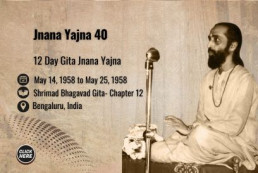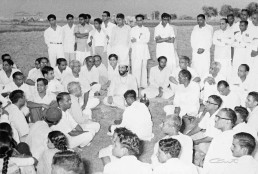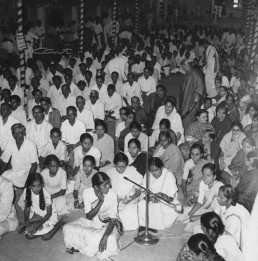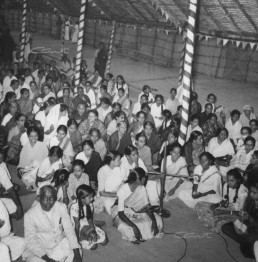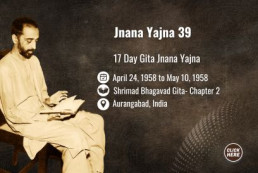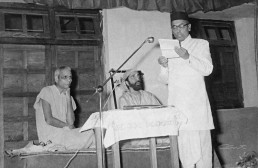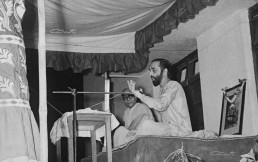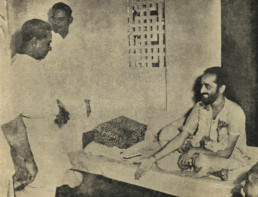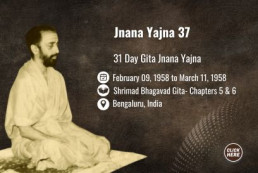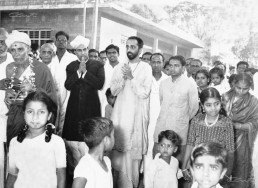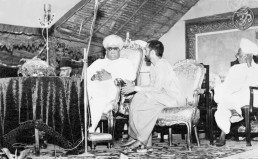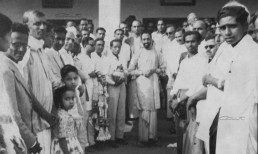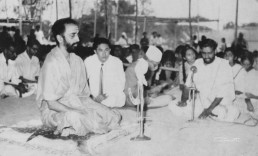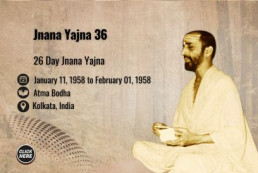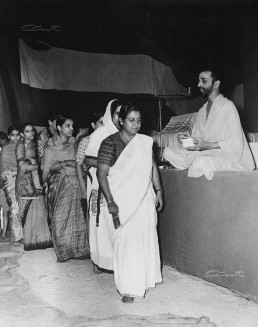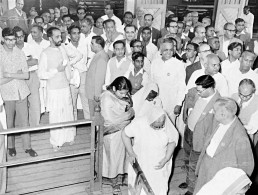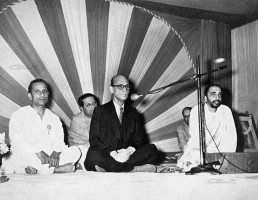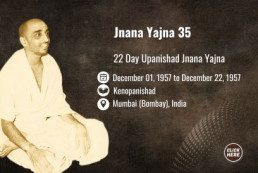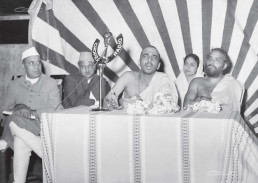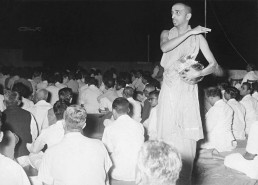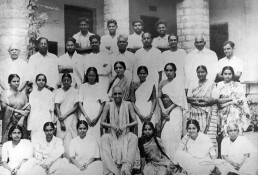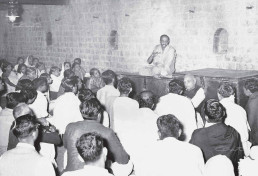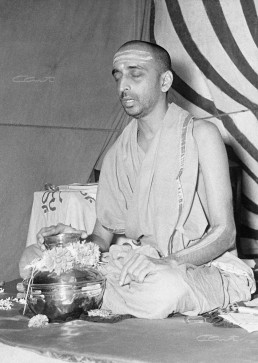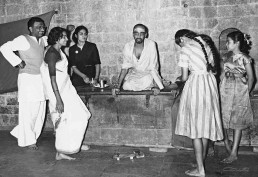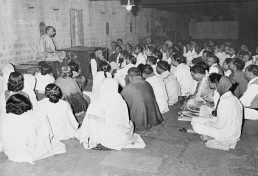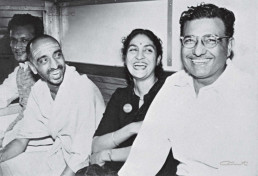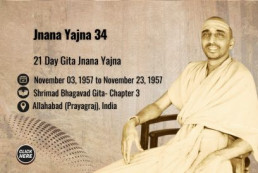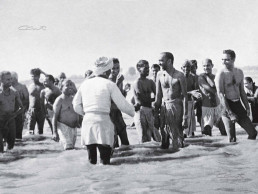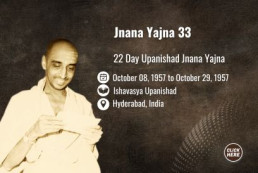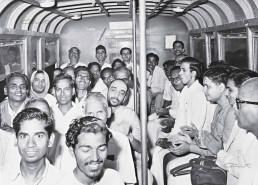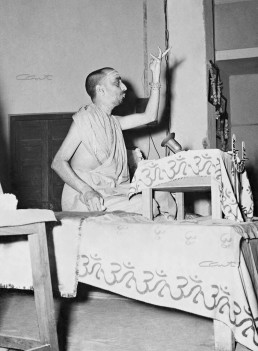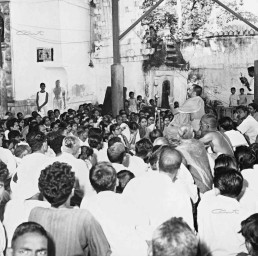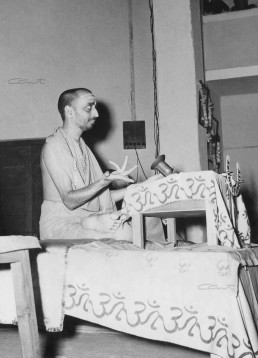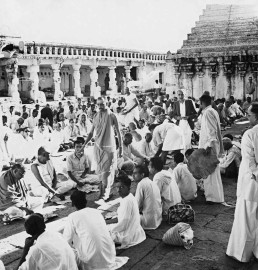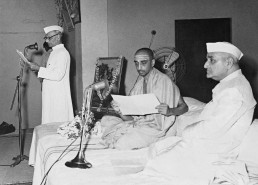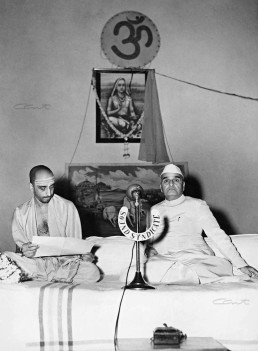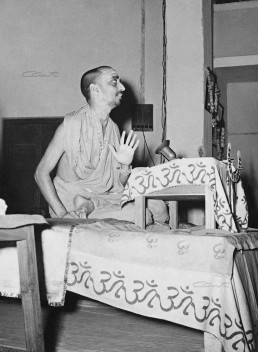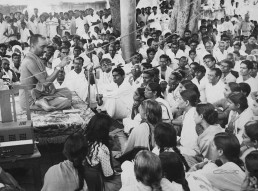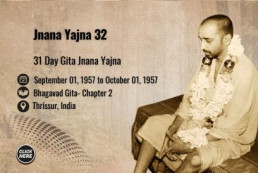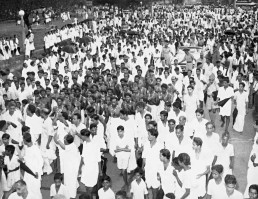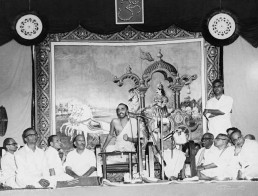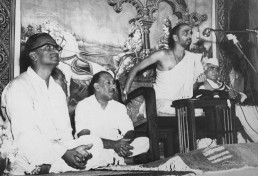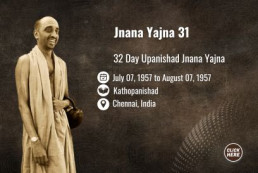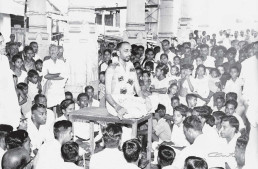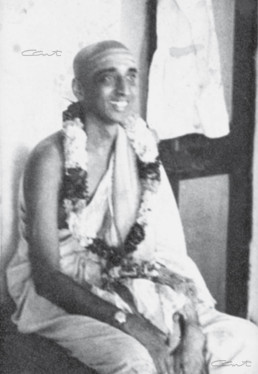Jnana Yajna 40
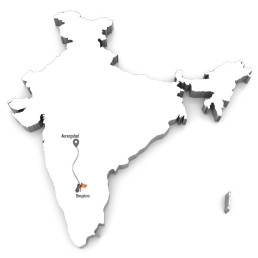
Jnana Yajna 40

Year & Dates:
May 14, 1958 to May 25, 1958

Yajna Topic:
Shrimad Bhagavad Gita- Chapter 12

Place:
Bengaluru, India.
With material progress, the concept of welfare has often overlooked a deeper, spiritual well-being. Having made an astute diagnosis before He undertook His Mission, Pujya Gurudev wanted the remedy from the scriptures to be distributed to all. So, on May 13, 1958, at a City Town Hall Meeting arranged by Chinmaya Mission, Bengaluru, He said: “In spite of the beautiful contributions made by science providing more and more comforts and amenities in the outer world, man is not happy today because of the maladjustments in his inner personality constituted by his own mind and intellect. He becomes a shattered personality and, like a man suffering from fever, he is not able to enjoy the ‘feast of life’ which the world provides for him. His heart contracts, and the intellect alone grows and ramifies…”
Developing the Heart
The 40th Jnana Yajna was arranged wishing for the true, wholesome welfare of over 5000 employees of Indian Telephone Industries Limited (now ITI Limited). And, Pujya Gurudev fittingly chose Bhagavad Gita Chapter 12 to revitalize the mind-intellect equipment.
On the evening of May 14th, inaugurating the yajna, Shri R.R. Diwakar, Chairman of the Gandhi Memorial Charitable Trust, pointed out that Hindu culture withstood the lashes of time only because of its spiritual roots. He added that the Gita was like a capsule encasing the curative essence of all Upanishads. Especially the Bhakti Yoga declared by Bhagavan Krishna in the 12th chapter presents a universal path accessible by all.
Pujya Gurudev, in His introductory discourse, cautioned that mere repetition of the mantras doesn’t strengthen spiritual culture. He defined Bhakti as an unmasking attunement with the Divine. Explaining thoroughly the unmanifest and manifest aspects of Bhagavan, along with the path, attitude, and attributes of a dear devotee, Pujya Gurudev indicated that developing the heart with divine love was equally important as advancing our intellect.
The audience of the 40th Jnana Yajna had the opportunity to express their devotion every evening. This is because of the bhajans they sang joyfully on the special buses while arriving into the ITI colony from all parts of Bengaluru.The other integrated features of the Jnana Yajna like the five -day Akhanda Kirtan, the Gita Havan, and the yatra to the sacred Arunaachala-Kshetra Tiruvannamalai for having the darshana of Arunaachaleshvara Bhagavaan also enriched the practice of devotion as learned from the Gita. On May 23, after the purifying Ganga sprinkling ceremony, Pujya Gurudev distributed about 1000 booklets of “Gayatri & Japa Yoga” to all the devotees, reminding that mantras and Japa gain potency only with devotion.
Photo Gallery
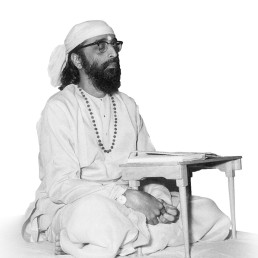
“Think,” Says Pujya Gurudev
Fix thy mind on Me Alone: The mind cannot contemplate on any theme that cannot be conditioned by the senses. Therefore, by meditation upon the enchanting form of the Immortal Flute-Player, the human mind can readily be made to rest entirely at the feet of the form. The Lord, being All-pervading, is at once the Divine Grace behind all names and forms. The mind of a devotee cannot wander to any place where he is not reminded of the smile of the Crowned Cowherd-boy!
From Shrimad Bhagavad Gita- Chapter 12, Book
Faith vs. Belief
Are belief and faith synonymous? Do our beliefs falter when confronted with life’s trials? Can we uphold faith even as our beliefs waver? Pause for introspection and contemplation as we explore the resilience and enduring strength of unwavering faith. Find answers to these inquiries and more in this enlightening discourse.
Jnana Yajna 39

Jnana Yajna 39

Year & Dates:
April 24, 1958 to May 10, 1958

Yajna Topic:
Shrimad Bhagavad Gita- Chapter 2

Place:
Aurangabad, India.
A gentle drizzle just before the inauguration of the 39th Jnana Yajna at Aurangabad, Maharashtra – it seemed like Varuna, the God of Rains, wanted to participate in Pujya Gurudev’s Gita Jnana Yajna. Unmindful of those sprinkles, an attentive audience awaited the glorious Chapter 2 of Bhagavan Krishna’s Eternal Song through the incomparable voice of Pujya Gurudev Swami Chinmayananda. After prayers at the nearby Khadkeshwar Shiva temple, the unfurled Om flag energized the atmosphere. Sri B. G. Ghate, the secretary of the yajna committee welcomed Pujya Gurudev and the gathering. And, Swami Ramanand Thirth inaugurated the yajna saying Gita showed the way to lasting happiness.
Opening His address with, “In this red-hot age of Sputniks and Hydrogen bombs, in this age of Science and Technology, in this age of Plans and Projects, you may be wondering why there are two Sadhus on the stage this day!” Pujya Gurudev attracted Aurangabad with His charming wit.
Through Heat and Rain
As Pujya Gurudev shifted into high gear in the discourses that followed, Nature too became intense. Aurangabad experienced an unusual heat wave, and then the skies poured. When the yajna committee tried to put up a shamiana (tent), their efforts were thwarted. Every evening, a storm brought down the new tent that had stood through a quiet day after being erected. Undisturbed by the onslaught of heat and rain, storm and thunder, Pujya Gurudev unfolded the exalted logic of Sankhya Yoga and Buddhi Yoga. Sheltered by His composure and immersed in the beauty of His exposition, the audience sat thrilled by the spiritual, intellectual, ethical, and traditional viewpoints that Pujya Gurudev presented.
Aurangabad is home to many artistic masterpieces. During this Jnana Yajna, Pujya Gurudev visited the acclaimed Ellora Caves, about 18 miles from Aurangabad. The aesthetic excellence of the Kailas Cave, in particular, launched Him into a state of supreme joy.
During the final days of the yajna, the Akhanda Kirtan from April 30th, the Gita Homa from May 2nd, and the Gangajal procession stirred devotion in all the awakened hearts of Aurangabad. The spiritual sojourn to the nearby town of Paithan and the Avabhruta Snanam in the Godavari river brought much happiness to devotees. Offering homage at the Samadhi shrine of the great saint of Maharashtra, Sant Eknath Maharaj was a fitting culmination. Pujya Gurudev, in yet another wonderful Jnana Yajna, demonstrated how the Gita view of life can certainly become a practical way of life.
Photo Gallery

“Think,” Says Pujya Gurudev
Yoga and Kshema in their meaning include all the activity of every living being on the face of the universe. These are the two urges which goad every one in all their activities. Yoga means ‘to acquire’ for the purpose of possessing them; and ‘kshema’ means ‘all efforts at preserving the acquired’. Thus the two terms Yoga and Kshema indicate all our ego-centric activities motivated by selfish desires to acquire and, compelled by equally selfish wishes, to hoard and preserve what has been acquired. To renounce these two temperaments is to immediately get away from the two main fields that yield the poisonous harvest of extreme restlessness and sorrow in life.
From Tyagi Magazine
Buddhi as defined in the Upanishad is a determining factor in the inner equipment; Nischayatmika is intellect; Samsayatmika is mind. Thus, when thoughts are in a state of flux and agitated it is called the mind; and when it is single-pointed, calm and serene in its own determination, it is the intellect. Thus Buddhi Yoga becomes “established in the devotion to intellect.” Steady in your conviction, your mind perfectly under the control of your better discriminative intellect, to live a master of your inner and outer work is called Buddhi Yoga.
From Tyagi Magazine
Embrace Death
Explore the profound wisdom behind the metaphor of death as a mere change in attire. In this insightful discourse, discover how the transition from one body to another is likened to shedding old clothes and donning new ones. Gain a deeper understanding of the timeless concept of mortality and the continuity of existence beyond physical form. Join us on a journey of contemplation and enlightenment as we delve into the eternal nature of change.
Jnana Yajna 38

Jnana Yajna 38

Year & Dates:
March 17, 1958 to April 10, 1958

Yajna Topic:
Shrimad Bhagavad Gita- Chapters 16 & 17

Place:
Tirunelveli, India.
Tirunelveli, Tamil Nadu – the temple town on the banks of the perennial Thamirabarani river, is praised in ancient literature including the Mahabharata. It abounds in sacrosanct temples which are also architectural marvels, like the famous Nellaiappar Kantimati Temple dedicated to Bhagavan Shiva and Goddess Parvati. Saints of both the Shaiva and Vaishnava orders were born in that town. A place of music and fine arts, Tirunelveli also made great, brave contributions to Indian history. Such a place of inherent spirituality was the venue of Pujya Gurudev’s 38th Jnana Yajna. On the evening of March 17, 1958, the inaugural day in the eminent Nellai Sangeeta Sabha, the heroic, modern sage of the Vedantic Renaissance, captivated thousands with His beaming face and majestic presence.
Language Above Words
Always considerate of the Vedantic aspirants of any background, Pujya Gurudev thought about the ability and difficulty of every seeker who walked into His Yajnashalas. To ensure that His explanations of Krishna’s Celestial Song as well as Adi Sankara’s Atma Bodha were understood by all, Pujya Gurudev enlisted the help of Sri T. Seshadri, a professor of the Madurai College, whom He humorously called “the Tamil Mouth of Swami Chinmaya.” With careful attention, Pujya Gurudev’s detailed discourses of both morning and evening were translated into Tamil. For 25 days, the people of Tirunelveli were soaring in sublime spirituality for five hours each day. They reflected on the value of virtues that Bhagavan Krishna lists in Chapter 16 and the warnings of vices. Pujya Gurudev and His translated talks emphasized the classification and role of Shraddha when explaining chapter 17. Serious seekers lost themselves in the deeper import of Atma Bodha’s striking examples.
The ardent devotees of Tirunelveli actively participated in the Akhanda Nama Kirtan from March 27th, in the 3-day Gita Homa from March 28th, and in the euphoric Ganga-jal procession. They accompanied Pujya Gurudev on April 5th to an awe-inspiring yatra to the holy seaside temple of Tiruchendur for a wondrous Avabhrta Snaana in the sea and a special darshan of Lord Subramanya.
When Pujya Gurudev’s Gita Jnana Yajna concluded after the heartwarming Gurudakshina ceremony on April 10th, His supremely seamless flow of knowledge, prayers, meditation, and satsangs had transported Tirunelveli into a bliss where language barriers didn’t exist.
Photo Gallery

“Think,” Says Pujya Gurudev
Devotion to knowledge (Jnana Yoga) is the positive way to persuade the mind to leave all its low temptations. When a child is playing with a delicate glass curio, to save the precious object, the parents generally offer a piece of chocolate, and the little child, anxious to get the chocolate, puts the precious thing down. Similarly, a mind that is awakened to the serener joys of the Self will, naturally, never hang on to the sensuous objects and their fleeting joys.
From Bhagavad Gita- Chapter 16, Book
As a man’s faith, so is he. Man is verily what his ‘faith’ is. The type of personality and its effectiveness or otherwise are all determined by the ‘faith’ under which it functions. That the achievement of life is ever colored by the type of faith with which the individual pursues his activities is very well-known and realized by all men of action.
From Bhagavad Gita- Chapter 17, Book
Play the Game of Life!
In this enlightening discussion, uncover strategies for navigating the myriad challenges and seizing the abundant opportunities that life presents. From mastering the power of intelligent responses to embracing the ever-changing landscape of existence, learn how to thrive amidst the dynamic interplay of circumstances. Join us and unlock the keys to living a fulfilling and purpose-driven life.
Jnana Yajna 37
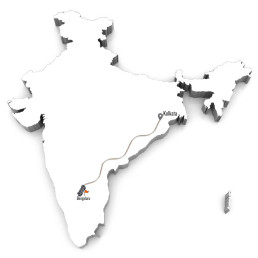
Jnana Yajna 37

Year & Dates:
February 09, 1958 to March 11, 1958

Yajna Topic:
Shrimad Bhagavad Gita- Chapters 5 & 6

Place:
Bengaluru, India.
It was the biggest pandal (tent) erected thus far in the open grounds of Malleshwaram, Bengaluru. Even so, by 6 pm on the evening of February 9, 1958, over 8000 people had occupied it. Given that the gathering was for Pujya Gurudev Swami Chinmayananda’s Gita Jnana Yajna, the overflowing audience had become a norm, not an exception. The 31-day yajna was inaugurated with grandeur and gusto by the Maharaja and Governor of Mysore, Sri Jayachamarajendra Wadiyar, and marked by an address by Maharaja Mohan Shamsher Jung Bahadur, the Rana of Nepal and patron of the Yajna Committee.
When Pujya Gurudev began His introductory talk chanting Om thrice with His inimitable voice, the pandal became a powerful Yajnashala. His voice stilled and thrilled the large gathering.
To Uplift and Give
To make man the master of life is the clarion call of Shrimad Bhagavad Gita. Pujya Gurudev stated that the noble idealism of the Gita must become an intrinsic part of life. Nourishing Bengaluru with both the milk and the cream – the Upanishad and its essence – Kenopanishad in the mornings and Gita chapters 5 & 6 in the evening sessions, Pujya Gurudev took the teeming audience to the peaks of Vedanta. He explained how renunciation can be gloriously incorporated in a path of detached action. His guidance on how to raise oneself through meditation inspired the audience; when Pujya Gurudev voiced the teachings of Bhagavan Krishna in chapters 5 & 6, He assured that renunciation and meditation could be practiced within the ambit of everyday life, slowly and surely.
The Akhanda Kirtan from February 27 to March 2, the three-day Gita Homa which concluded on March 2, and the memorable Avabhrta Snaana at the renowned Tirumala Temple Pushkarani (tank) on March 9 – in and through each aspect of the Jnana Yajna, Pujya Gurudev brought out the spiritual in the ritual.
Another outstanding and elevating part of all Jnana Yajnas that Pujya Gurudev conducted was the Guru Dakshina ceremony which became a hallmark of Chinmaya Mission. The ceremony of revering the Teacher who blesses disciples with the Abundance of Truth and Happiness is an ancient Vedic tradition. Pujya Gurudev needed nothing and gave everything. The Guru Dakshina ceremony was the devotees’ thanksgiving that upheld and supported not just Chinmaya Mission; often, the Guru Dakshina collected was shared in charity to serve many. And, as in other yajnas, every devotee was given a free copy of the Yajna Prasad. In the momentous 37th Jnana Yajna, the Guru’s blessing was “Hinduism at a Glance-Gita.” Pujya Gurudev instilled the practice of giving back even in the Guru Dakshina ceremony.
Photo Gallery

“Think,” Says Pujya Gurudev
Self-realization is not a melancholy parade crawling to a pre-destined tomb, but it is a joyous ride to the Palace of Truth, from which man had wandered away in his own ignorance and confusion. A true prophet-not an assumed one, laboriously keeping to himself the unnatural pose of an unrealized perfection-is one who lives himself consumed in an ever reviving fire of love. He ceaselessly strives to bring out “himself” from the rubbish that is veiling his own Self in all other forms around and about him. This is indicated by the term “engaged in the good of all-beings”.
This loka-seva becomes his recreation, his self-appointed engagement. His body, mind and intellect are offered as oblations into the sacred fires of activity and while remaining at rest with himself the Saint lives on in an unbroken Consciousness of the Divine, the Eternal.
From Bhagavad Gita- Chapter 6, Book
Thoughts appear in the mind at every second in a continuous stream, and these constant thought disturbances, each dying yielding place to a new one, gives us the apprehension of a solid factor called the mind. Similarly, the tip of a flame also, (it can be experimentally proved) is never steady, but the continuity of its change is so fast that it gives us an apparent illusion of solidarity.
When this flame is well protected from the fickle breeze, then it becomes steady in its upward flights. In the same fashion the flame of the mind, flickering at the whims and fancies for the passing sensuous desires, when arrested in a meditator, becomes steadily brilliant, although the mind is made to contemplate upon the Self by a constant flow of Brahmaakaara-vritti.
From Bhagavad Gita- Chapter 6, Book
Nobody can help Anybody!
Bhagavad Gita serves as a guidebook for navigating life’s trials, empowering individuals to find strength within themselves. Explore how to cultivate a mindset of equanimity and balance, enabling you to navigate through life’s ups and downs with grace and resilience.
Jnana Yajna 36
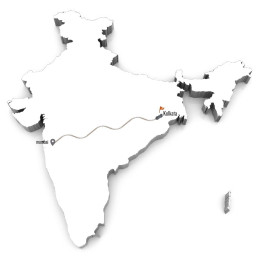
Jnana Yajna 36

Year & Dates:
January 11, 1958 to February 01, 1958

Yajna Topic:
Atma Bodha

Place:
Kolkata, India.
When we welcome a new year, we usher in the resolve for higher aspirations. With that enthusiastic spirit, opening 1958 with a Jnana Yajna by Pujya Gurudev Swami Chinmayananda was Kolkata’s great fortune. It was the third Yajna in the city; Pujya Gurudev had taught the poetic, profound Atma Bodha in the early morning classes in many places including Kolkata, but this was the first Yajna where Atma Bodha was going to be elaborated during the two-hour evening primetime.
Pujya Gurudev was received ceremonially at 6:30 pm on January 11, 1958. After the Om flag was unfurled and hoisted, He was escorted with exuberant chanting of the Mahamantra in a graceful procession onto an aesthetically decorated stage. The beginning was spectacular, and the next twelve days of discourses were spell-binding with the rich similes of Atma Bodha.
Master of Circumstances
The 36th Jnana Yajna at Kolkata had also the twist of the unexpected. On the calm evening of December 23rd, just the day before the planned Havana, the devoted Akhanda Kirtan of “Hare Rama” was interrupted by the cries of “Fire, Fire!” In a matter of just five minutes, the huge tent with all the expensive idols and equipment was reduced to ashes by a raging inferno. Hearing about that fearsome blaze, Pujya Gurudev remarked with His characteristic composure: “Agni Bhagavan decided not to wait for the Havana tomorrow to visit us. Do you not discern His Protecting Hand in the fire breaking out at 5:30 pm. and not at 6:30 pm.?” Indeed, if the fire had broken out just an hour later during the discourse, it would have ended in a tragic disaster. It was a sheer miracle that no life was lost.
Personifying equipoise, Pujya Gurudev reassured the shaken people and continued His Jnana Yajna at the Gujarati Bala Mandir for the next few days. Guided by His unshakable strength, the Kolkata Yajna Committee re-erected a new, bigger tent on the very same fire-ravaged land. The Yajna was a roaring success as the program was improvised. Instead of a scheduled trip to the Triveni Sangam, a steamer trip to the Ganga Sagar Island was scenic and memorable; the small snags dissolved in the sheer bliss of Pujya Gurudev’s Presence. From February 3, 1958, the Havana inside that new pandal and Akhanda Kirtan commenced with fervor and faith. When the final 68th verse was explained on February 5th and the Ganga waters were sprinkled by Pujya Gurudev on the blessed audience of Kolkata, the spiritual fulfillment felt was beyond words.
The unforgettable Jnana Yajna ended when the Om flag was unfurled. It had been flying high, untouched by the hungry flames, symbolizing the unscathed Atma that Pujya Gurudev extolled.
Photo Gallery

“Think,” Says Pujya Gurudev
In cooking food, items such as vegetables, rice, spices, etc., are “contributory” causes; but by themselves they can never constitute food. Fire alone can accomplish the cooking; fire is the direct cause. Similarly, the performance of rituals, the offering of gifts, the practice of austerities, control of the mind, the study of the scriptures, the use of the discriminative intellect are all, no doubt, helpful factors which aid one’s spiritual growth, but they do not by themselves directly lead one to liberation. Liberation is possible only when the true Knowledge of our own existence is realized, or the glory of our Self rediscovered.
From Atma Bodha Book
Without this, Success is Far!
What is the role of tapas in channeling mental energy towards creative pursuits and achieving goals? Can it help preserve my mental vitality? And is success possible without this mental vitality in any field? Listen to the video to know more.
Jnana Yajna 35
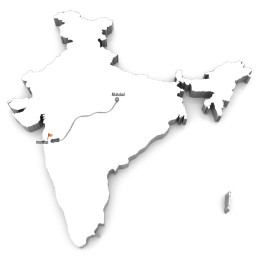
Jnana Yajna 35

Year & Dates:
December 01, 1957 to December 22, 1957

Yajna Topic:
Kenopanishad

Place:
Mumbai (Bombay), India.
Though the nearby city of Pune had the great honor of being the site for Pujya Gurudev’s first Jnana Yajna, Mumbai(then Bombay) had to wait for about six years. Only in December 1957, could Mumbai host its first Upanishad Jnana Yajna by Pujya Gurudev. The well-known Kishinchand College (K.C.College) in Mumbai offered its terrace as the happy venue. Drawing attention to how Vedanta had withstood onslaughts because of its adaptability and resilience, Pujya Gurudev was emphatic that Vedanta was for all. His systematic 5-day introductory discourses prepared the Mumbai audience for the subtle import of Kenopanishad. His hourly talks every morning on Atma Bodha in Vijay Mahal embellished the understanding of serious seekers. As had become His practice, Pujya Gurudev set aside time to address the young generation of college students who needed the crucial know-how to harmonize Science and Religion.
Mankind, Religion and Science
In a memorable talk at Poddar College on December 25, 1957, Pujya Gurudev presented a thought-provoking analogy. Comparing mankind to an old man, religion to a long-standing, faithful spouse, and science to a young, attractive maiden, Pujya Gurudev showcased the predicament of mankind. With science racing ahead and mankind abandoning the loyal support of religion, Pujya Gurudev pinpointed how mankind was lost in the middle.
Every yajna of Pujya Gurudev was aimed at rejuvenating religion and helping mankind understand its value in the presence of advancing science. In Mumbai too, the special lectures at colleges, the Upanishad discourses, kirtans, meditation sessions, and the sacred Ganga prokshan (sprinkling) affirmed how the people of a busy city could tap into the blessings of religion.
The yatra to Alandi near Pune was a sacred experience. Aspirants could bask in the peace of Sant Jnaneshwar’s samadhi and complete the Avabhrta Snana in the Indriyani river. The satsang with Pujya Gurudev under a banyan tree transported all to the Vedic times. After that, when each seeker meditated for half an hour in seclusion, the significance of the scriptures came into focus. Pujya Gurudev aimed to empower mankind with a clear understanding of both religion and science.
Photo Gallery
Bombay is blessed to see Nirmal Maharaj (Lion of Vedanta in Hindi) and Swami Chinmayananda, Two Spiritual giants on the same dais!
Swami Chinmayananda during the 35th Yajna: Inauguration L to R: Lala Jaganath, Swami Chinmayananda, Mrs Sheel Dewan (back) and Swami Nirmal Maharaj (Chief Guest) known as "the Lion of Vedanta in Hindi"

“Think,” Says Pujya Gurudev
A child, trying to catch the head of its own shadow, moves forward and forward, but at each leap the goal too moves as far away from it as before; until at last it falls off the verandah onto the court-yard!! So too man seeking a permanent Joy among the impermanent things, falls off into his grave!!Alas!!
That deer which knows that the source of the Musk Secret is within itself, shall no more run about and die away in futile and meaningless exhaustion. The Man who has recognized the Truth that the source of All Joy is within himself will no more strive and struggle in the meaningless dust and fume, hustle and bustle, noise and nuisance of the broadways. To him life becomes a hilarious, melodramatic scene, and not a serious tearful tragedy of his own impotence and failures!
From Kenopanishad Book
Remedy for an Unhappy Mind!
In this profound exploration of Consciousness and thought, discover the remedy for an unhappy mind. Join us as we unravel the teachings on transcending the fluctuations of the mind to find inner peace and clarity. Learn how to shift your focus from the contents of your thoughts to the illuminating light of Consciousness that permeates every aspect of your being. Through practical techniques and insightful wisdom, uncover the path to Liberation from the grip of unhappiness.
Jnana Yajna 34

Jnana Yajna 34

Year & Dates:
November 03, 1957 to November 23, 1957

Yajna Topic:
Shrimad Bhagavad Gita- Chapter 3

Place:
Allahabad (Prayagraj), India.
Acclaimed as a great place of pilgrimage near the holy confluence of the clear waters of the Ganga, the green waters of the Jamuna, and the river Sarasvati, Prayagraj brings to mind the pristine flow of Sanatana Dharma. However, religion had become stagnant ritualism in the 1950s, and Prayagraj needed a dynamic boost.
Six years and 33 Jnana Yajnas after Pujya Gurudev flagged off the Vedantic Renaissance, He arrived at Prayagraj. Unmindful of His own burning fever and a sore throat, Pujya Gurudev quenched the spiritual thirst of an audience who craved for more after hearing His incomparable explanations of the third chapter of Bhagavad Gita. All roads lead to wherever He was, to listen, learn, and soak in the spiritual abundance of His teachings. Every association, club, society, and organization vied with one another to invite Him and host His talks.
A Confluence of Wisdom, Words, and Worship
Invited by the Allahabad Students Union, Pujya Gurudev addressed the students in a set of powerful discourses titled, “Your life is yours. Make it or mar it.” Initial skepticism from the youth on the first day rapidly turned into admiration and attention. Word spread and attendance peaked. Chairs were pushed farther back making place for more students to sit on carpets. But that too wasn’t enough. Students stood in the verandah and the upper gallery, grabbing every inch of space and hanging on to each word that Pujya Gurudev uttered.
An astute Teacher that He was, Pujya Gurudev announced a prize of Re.100 for the best essay written on ‘Religion and its place in Modern Life.’ The sight of hundreds of students taking notes at a fiery pace was proof of the revival of Sanatana Dharma among the motivated youth.
In several of His initial Jnana Yajnas, Pujya Gurudev had incorporated the feature of essay contests. This encouraged avid listeners and seekers to internalize and apply the wisdom of the scriptures in their own lives. The winners were given a small cash prize and the best essay was published in earlier editions of Tyagi.
Besides the words to remember, the spirited kirtans on boats at the Triveni Sangam, the meaningful satsang on the banks of Ganga, and the sincere worship at Shivkuti temples – the people of Prayagraj marveled at and adored the ways Pujya Gurudev refreshed their spiritual perspective.
Photo Gallery

“Think,” Says Pujya Gurudev
The philosophy of Geeta does not suggest even in its implications any kind of running away from the world of sense-objects. Krishna’s creed is to be lived here and now among one’s situations in life and in this very world, and is to be experienced through our sacred vehicles of the body, mind and intellect. The only insistence is that on all occasions a wise man should be a master of the vehicles and not a helpless victim of these matter envelopments. And the secret of this mastery in life is to live free from the tyrannies of attachments and aversions.
From Tyagi Magazine
Unlocking Success
Witness the beauty of selfless service, its transformative power and the impact it can have on shaping a harmonious and compassionate society and as a pathway to success and fulfilment.
Jnana Yajna 33
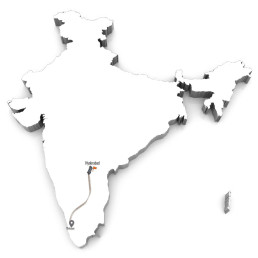
Jnana Yajna 33

Year & Dates:
October 08, 1957 to October 29, 1957

Yajna Topic:
Ishavasya Upanishad

Place:
Hyderabad, India.
Only ten months before, just as 1957 was ushered in, thousands had thronged the Andhra Yuvathi Mandali, Barkatpura in Hyderabad. They had tasted the sweet devotion and recognized the field and the Knowing Principle that Pujya Gurudev Swami Chinmayananda had presented through the Gita Jnana Yajna of chapters 12 and 13. With their spiritual appetite kindled, they assembled again on October 8, 1957 at 6 pm. After Col. K. N. Waghray, President of the Yajna Committee, hoisted the Om flag, he began, “Swami Chinmayanandaji has chosen Ishavasya Upanishad as the theme of His discourse this time. The purpose of this Upanishad is to teach the essential unity of God and this world.”
Selfless, Spiritual Outlook
Pujya Gurudev’s choice was timely since spiritual and material integration of the modern man was the need of the hour, in the turbulent 1950s, especially in India; only the enduring wisdom of the Upanishads could offer a comprehensive and lasting solution. Shri Bhimsen Sachar, the Governor of Andhra Pradesh, who inaugurated the yajna and unveiled the portrait of Adi Shankaracharya, appealed for a changed outlook based on scriptural understanding. In His opening discourse, Pujya Gurudev was forthright and clear: “Turning to God in darkness is not true religion, and it would only amount to temporary adjustment and compromise. True religion means a correct understanding of the questions like ‘Who am I? From where have I come? And what is the purpose of life?’”
To build that understanding, Pujya Gurudev explained, in His morning sessions, the path to Self-Awareness using the succinct verses of Atma Bodha written by Adi Shankaracharya. Then, His discourses in the evening on the pithy 18 verses of the Ishavasya Upanishad made the audience review the world in a different, divine light. The majestic vision that Pujya Gurudev inspired in the audience was evident in the other limbs of the Jnana Yajna – the soulful Akhanda Kirtan, the devout Maha Mrtyunjaya Homa, the purifying sprinkling of Ganga waters, as well as the sacred bath and prayers at the Vemulawada Uma Maheshwara temple 130 miles from Hyderabad. Whether in the yajnashala or through His lectures to students of Osmania University, Pujya Gurudev unceasingly steered everyone to look out with a unifying Upanishadic lens and make work a selfless offering.
Photo Gallery

“Think,” Says Pujya Gurudev
The Upanishads have glorified sweat and toil to the highest pinnacles of recognition. ‘Dignity of Labour’ is nowhere so openly declared and religiously glorified as in the Hindu scriptures. Dedicated and noble work alone can polish the animal-man to a state of true cultural and right discipline. To those who know what it is, work is not a slavery or a drudgery but it is the Chutney of life. But when a dissipated and demoralized generation have in their misconstrued enthusiasm fallen off their track into a disastrous wreckage, they tumble down into the pits of “more wages and less hours”!! To them even “no work and all money” would still be only a state of terrible and agonizing discontentment!! Man is not born to revel in idleness.
From Ishavasya Upanishad Book
You are Searching in the Wrong Place!
As we unravel the mysteries of consciousness and reality, we confront a fundamental question: are we searching in the wrong place? In this thought-provoking discourse, learn how to transcend worldly distractions and turn your attention towards the ultimate reality, Paramatma. Prepare to shift your perspective and embark on a quest for deeper understanding and inner awakening.
Jnana Yajna 32

Jnana Yajna 32

Year & Dates:
September 01, 1957 to October 01, 1957

Yajna Topic:
Bhagavad Gita- Chapter 2

Place:
Thrissur, India.
The excitement was building up in the sprawling maidan (open grounds) before the famous Vadakkunnathan Temple of Thrissur, the cultural capital of Kerala. People of all ages, backgrounds, and faiths had convened well before 5p.m on that wondrous evening of September 1, 1957. Soon, the resonant melodies of Panchavaadya and Naadaswara filled the air as royally decorated elephants moved rhythmically to divine bhajans. Fireworks lit up the sky in sparkling joy. And, in the orange hue of the evening, all eyes were fixed on the tall figure standing inside a bedecked convertible. A youth during his student days, beloved to Thrissur as “Balan,” had arrived as the glowing and eminent Swami Chinmayananda for a much-awaited Gita Jnana Yajna.
Victory, Open to All
The Governor of Kerala, Sri Ramakrishna Rao, unfurled the Om flag and inaugurated the yajna. In the yajnashala graced by the portrait of Swami Tapovanam and the divine idol of Sri Krishna, a mellow prayer song, “Akhilanda Mandalam,” which was Pujya Gurudev’s favorite, sounded the perfect starting note. The song’s refrain, “Vijayikka nin thiru Namangal Paadi – Singing Your Great Names, May we achieve victory” was meaningfully apt. Pujya Gurudev’s introduction about “Vedanta, the Philosophy of Life” and Shrimad Bhagavad Gita roused the audience. Thereafter, everyday, from 6-8p.m, He transported all into the paradise of the enlightening second chapter. To the Christians who attended regularly in large numbers, he welcomed them without distinction saying, “Gita is not meant for a particular caste or creed ; it is meant for Man. It points out the way to Man, how to live his best, individually, as well as a society or as a nation.”
The Atma Bodha classes in the early mornings, a 5-day Akhanda Kirtan from Sep.18, and a four-day Gita Homa from Sep.19 culminating in a huge procession with the Ganga waters – Thrissur was awash with spiritual fervor. Pujya Gurudev eloquently unfolded Sankhya Yoga and answered questions for two days after concluding His discourses. The Avabhrta Snaana at the scenic Sri Rama Temple at Triprayar was an unforgettable blessing. Beholding at night that illuminated temple beside the flooded river that carried hundreds of lamps lit on paper boats, devotees were enveloped in that sacred radiance. Thrissur was immersed in a mighty flow of Jnana, Karma, and Bhakti, transformed by Pujya Gurudev’s astounding Gita Jnana Yajna.
Photo Gallery

“Think,” Says Pujya Gurudev
Death grins only at those who have no understanding, and it has no pain for those who understand its implications and working. Just as changing dress is no pain to the body, so too when the dweller in the body leaves the envelope there is no pain possible; and by undressing it does not mean that there after we are ever to live naked. So too, this embodied Self ere long discovers and appropriate equipment from which to function so as to earn for itself new sets of experiences. Evolution and change are all for the mind and intellect and not for the Self. The Self is perfect and changeless, and needs no evolution in Itself.
From Tyagi Magazine
Even this will pass away!
Explore the profound wisdom of the Bhagavad Gita as it reveals the transient nature of life’s experiences. Learn to navigate the highs and lows, knowing that every joy and sorrow is fleeting, and discover the enduring truth that lies beyond them.
Jnana Yajna 31
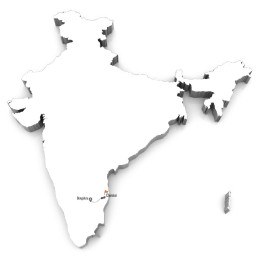
Jnana Yajna 31

Year & Dates:
July 07, 1957 to August 07, 1957

Yajna Topic:
Kathopanishad

Place:
Chennai, India.
A busy road in the middle of a business district in Chennai paused to ponder when Pujya Gurudev Swami Chinmayananda brought the heartwarming Kathopanishad to town. Chennai’s fifth Jnana Yajna, the boon of Kathopanishad materialized in a large pandal (tent) erected right on Mount Road (now Anna Salai). The thousands who were thirsting to hear the commanding voice of Pujya Gurudev again were delighted. With the Om flag flying high, Pujya Gurudev signaled study time: “The Upanishads are original sources of the knowledge of life given to us by the immortal seers and sages. Kathopanishad is the most sublime of them all for it contains in itself the poetic fervor and philosophic alertness of our forefathers.”
Tasting Sannyas after Study
From July 7th, the involved audience hung onto every word of Pujya Gurudev’s -they waited with Nachiketa, rejected distractions offered by the world, and wanted only That Knowledge that outlasted death.
One notable experience that Pujya Gurudev had incorporated from the earliest yajnas was what He called “returnable sannyas.” He took four hundred eager seekers of Chennai on an unforgettable journey of a ‘one-day-sannyas’ starting at 5 pm the evening of August 3, 1957. Fervent chanting, bhajans, a joyous dip in the sacred Kollidam river, and the blissful Darshan of Lord Shiva as Nataraja and Lord Vishnu as Govindaraj at Chidambaram – divinity pervaded every minute. Pujya Gurudev then took them to Ramalinga Jothi, a great Tamil saint’s samadhi sthal which had a Tamil inscription of “Be ever hungry, ever in solitude, and ever vigilant.” To elevate Bhakti and Jnana through silent Japa Yoga, Pujya Gurudev guided them to the meditative Aurobindo Ashram in Pondicherry before returning to Chennai. A whirlwind visit in temporary orange was the briefest glimpse through which Pujya Gurudev indicated what Nachiketa gained forever in Kathopanishad.
Photo Gallery

“Think,” Says Pujya Gurudev
This question whether there is experience after death or not is not one which belongs to the Realm of the Mind and the Intellect. These instruments of feeling and knowing do, at their best, give us only some vague directions pointing towards a World of Knowledge that actually lies spread out beyond their own frontiers. In order to travel towards that Land of Pune Knowledge the ordinary mortal, however intellectual and sensitive he may be, has not the necessary vehicle. It is only the great Masters of renunciation and wisdom who have specially developed their intuitive faculty that can at will take one into these Realms Beyond.
From Kathopanishad Yajna Prasad
Say No to Yourself!
Contemplate on the fundamental choice between the path of righteousness (Shreya) and the path of immediate pleasure (Preya), and learn how refusing to compromise on higher values leads to lasting fulfillment and spiritual growth.
